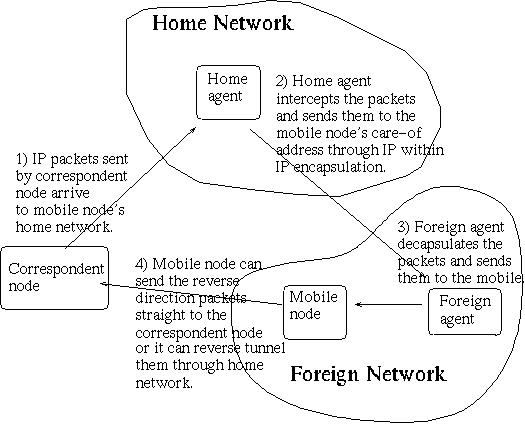
Vesa Lindqvist
Computer Science and Engineering
Helsinki University of Technology
Vesa.Lindqvist@hut.fi
4 Micro mobility in Mobile IPv6
The sections of this paper contain:
When the mobile node notices that it has arrived to a foreign network, it obtains a care-of address. The care-of address can be determined by a foreign agent or with the Dynamic Host Configuration Protocol (DHCP). Then the mobile node registers its care-of address with its home agent. After this the home agent knows where the mobile node is located.
The home agent intercepts the IP packets that have been sent to the mobile node's home address and sends them through IP within IP tunnel to the mobile node's care-of address. At the end of the tunnel, the extra IP layer is removed and the packet is delivered to the mobile node. The endpoint of the tunnel may be at the foreign agent or at the mobile node itself. After the registration with home agent the IP packets sent to the mobile node's home address can again reach the mobile node. [1]
The packets that are going to another direction from a mobile node to a correspondent node can be routed through the IP within IP tunnel via home network to the correspondent node or the mobile node can send them straight to the correspondent node. Because of so called ingress filtering it is not usually possible to send the packets normally via the shortest path and the packets going from the mobile node to the correspondent node have to be routed via the home network. A router that is performing ingress filtering is blocking out IP packets that come from topologically incorrect addresses [8]. In Mobile IPv4 the packets that are going from the mobile node to the correspondent node may sometimes contain a topologically incorrect source IP address. Because of this the reverse tunneling has to be used in Mobile IPv4 [9]. It is non optimal because the IP packets always have to go through the home network. However, the reverse tunneling problem has been solved in Mobile IPv6 [2].
The Figure 1 summarizes the basic data routing in Mobile IPv4. Detailed description of Mobile IPv4 is in the protocol specification in RFC 2002 [1].

For example, in Mobile IPv6 the correspondent node can cache mobile node bindings so that it can send IP packets straight to the mobile node, so that the packets do not have to be delivered via the mobile node's home network. This, for example, solves the problem of reverse tunneling so that the mobile node can always send its return packets to the correspondent node without routing them through the home network. This means that routers in the Internet can perform ingress filtering without disturbing the mobile nodes.
Another major improvement is that there is no need for foreign agents anymore. In Mobile IPv6, the mobile nodes can handle most of the foreign agent's tasks with the enhanced features of Mobile IPv6. However, there is need for some special kind of network elements in the visited networks.
The Figure 2 summarizes the basic functionality of Mobile IPv6. The detailed description of Mobile IPv6 protocol proposal can be found at IETF's Mobile IPv6 protocol draft [2].
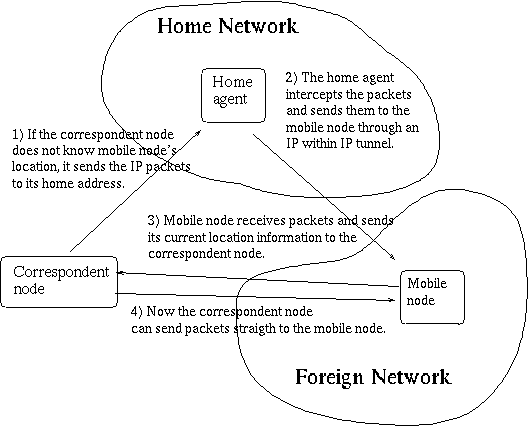
The mobile nodes may change their point of connection to the Internet very frequently. The change of an access point during active data transmission or reception is called a handoff.
In the basic Mobile IPv4 protocol, the new location of the mobile node is registered all the way with the home agent. And in standard Mobile IPv6 case the location information is also transferred to the correspondent node. The mobile node's packet loss during and after handoffs may be disturbingly high, because the delay of informing the home agent, possibly on the other side of the world, may even be several seconds in the current Internet. Also, for mobiles that are using Quality of Service (QoS), acquiring a new care-of address on every handoff would trigger the establishment of new QoS reservations between the home agent and the foreign agent [5]. However, most of the path from mobile node to a correspondent node would be the same before and after the handoff.
There are several suggestion to handle the problem of micro mobility that are presented in this paper. In all of these proposals, the home agent does not have to be aware of every handoff the mobile node performs, because the visited network takes care of the small movements - the home agent only has to know in which network the mobile node is located. The basic Mobile IP protocol can also be used to solve the micro mobility problem, but it would result in control data overhead due to frequent notifications to the home agent and delay during handoff.
The solution for micro mobility problem is non-trivial and it is not possible to say which solution would be the best for all situations. The following list presents criteria that can be used to compare and classify the proposed solutions.
Some of these criteria are also affected by other things that are
out of this paper's scope. For example, the choice of physical network
technology has a strong effect on handoff delay.
| Term | Description |
| Active mobile host | A mobile host is in active state if it is transmitting or receiving IP packets. (relevant in cellular IP) |
| Care-of address | The care-of address means the termination point of the tunnel between the home and the foreign agent.If the foreign agent is not used, the termination point is at the mobile node. The care-of address may change when the the mobile node moves. |
| Cellular IP gateway | A cellular IP node that is connected to a regular IP network by at least one of its interfaces. |
| Cellular IP mobile host | A mobile host that implements the cellular IP protocol. |
| Cellular IP node | A cellular IP network consists of interconnected cellular IP nodes. They route IP packets inside the cellular IP network and communicate with mobile hosts. Referring to the latter role, a cellular IP node that has a wireless interface is also called a base station. |
| Correspondent node | A node with which a mobile node is communicating |
| DHCP | The Dynamic Host Configuration Protocol (DHCP) provides configuration parameters to Internet hosts. DHCP consists of two components: a protocol for delivering host-specific configuration parameters from a DHCP server to a host and a mechanism for allocation of network addresses to hosts. |
| Foreign agent (FA) | A foreign agent is a router in the mobile node's visited network that provides routing services for the registered mobile nodes. The foreign agent detunnels and delivers IP packets to the mobile node that were tunneled by the mobile node's home agent. The mobile node can also communicate with home agent without using the foreign agent. The foreign agent exists only in Mobile IPv4, but not in IPv6. |
| Gateway foreign agent (GFA) | In regional tunnel management, visited domain contains one foreign agent that acts as the leader of all the foreign agents. The mobile node's care-of address is the GFA's address and the mobile node can move between other foreign agents without registering to the home network. |
| Handoff | A change of the connection point to the Internet during active data transmission or reception. |
| Home address | A mobile node has a home IP address that remains the same despite the point of attachment to the network. |
| Home agent (HA) | A home agent is a router in the mobile node's home network that intercepts and tunnels IP packets to the mobile node when it is not in the home network. |
| Home domain | The domain where the home network and the home agent are located. |
| Ingress filtering | A router that is performing ingress filtering rejects IP packets that include a topologically invalid IP address as the source address. Because of this the mobile nodes are usually not able to send their IP packets directly to the correspondent node in Mobile IPv4. |
| Local care-of address | A care-of address which is either assigned to a mobile node, or to a foreign agent offering local connectivity to a mobile node. A registration message from the mobile node is subsequently sent to a GFA via the local care-of address. |
| Mobile node | The mobile node is a computer that changes its point of attachment to the network. When visiting in a foreign network, the mobile node registers its new location with the home agent and is able to continue communicating with the same IP address. |
| Node | A node can mean any network element. It may, for example, be a mobile computer or a router. |
| Paging cache | A cache maintained by some cellular IP nodes, used to route packets to mobile hosts. |
| Regional registration | In hierarchical mobile IP proposals, the mobile node makes regional registrations to the GFA. They are local because the mobile node's home agent does not have to be aware of them. |
| Visited domain | The domain where the visited network, the current foreign agent and the GFA are located. |
The following subsection concentrates around the regional tunnel management [3]. However, other hierarchical proposals exist, for example, the RAFA [10] and Dynamics HUT Mobile IP [11].
If the foreign network supports regional tunnel management, there is a special kind of foreign agent called a gateway foreign agent (GFA). The mobile node uses the GFA's IP address as its care-of address when it registers with the home agent. This care-of address does not change when the mobile node moves between the foreign agents that are located under the same GFA. After first registration, the mobile node makes its registrations with the GFA. Registrations are not done with the home agent as long as it is moving under the same GFA. If the mobile node changes GFA, within or between visited domains, it must again register with the home agent. Because the binding of the mobile node must not expire at the home agent, there also has to be regular registrations with the home agent. [3] The Figure 3 illustrates the basic idea of hierarchical Mobile IP.
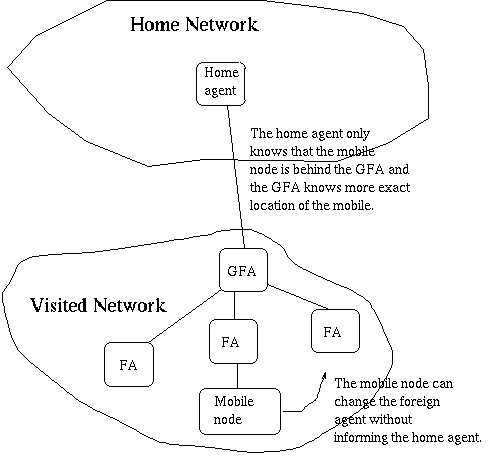
The mobile node does require extra support for regional tunnel management.
The changes are caused by different types of registration messages and
security issues. Also changes are needed to the home agent, if it is acting
as a key distributor for the GFA and the mobile node. Otherwise, the home
agent assumes that the mobile node is not at all moving in the visited
network because its care-of address remains the same.
One of the main differences to the other micro mobility solutions is that in cellular IP the location management for idle mobile hosts is different from hosts that are actively transmitting or receiving data.
Figure 4 illustrates the basic structure of Internet containing networks implementing the cellular IP protocol.
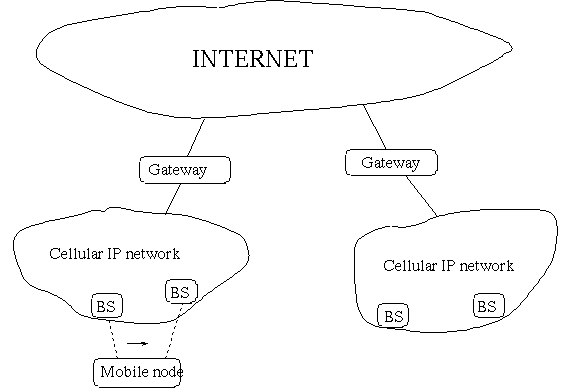
The base stations periodically broadcast beacon signals and mobile
hosts use them to locate the nearest base station. A mobile host can send
an IP packet to the Internet by sending it to the nearest base station.
The base station then routes the packet to the cellular IP gateway providing
access to the Internet.
All the cellular IP nodes are responsible of maintaining a cache containing routing information. An entry in the cache binds the mobile node's IP address with the direction where the mobile node is located. When a mobile node sends an IP packet, it goes through the necessary cellular IP nodes and after that the nodes have the necessary information about the mobile node's location. Every cellular IP node knows only the next hop to the downlink direction. The mobile node's reverse direction packets can be delivered through the same path. The Downlink and uplink idea is illustrated in the Figure 5.
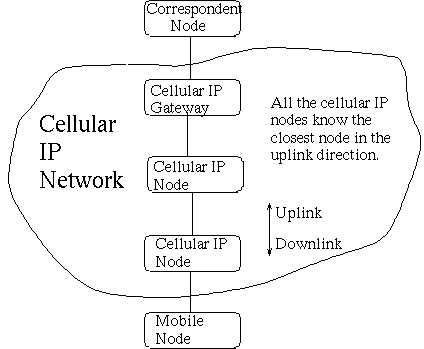
If the mobile host is not actively sending or receiving data, but it wants to remain reachable, it can let routing caches in cellular nodes expire. Some of the cellular IP nodes contain so called paging cache that has longer time out. However, finding the mobile node is bit a more difficult if there is only an entry in the paging cache and not in the routing caches. When the mobile node is in the active state, it has to inform the network of each handoff and because of this the routing caches are uptodate. When the mobile node is not in the active state, it is better that it does not inform network about every movement, because usually the mobile nodes have limited batteries. This means that the signaling information sent by mobile nodes in non active state have to be minimized. This problem is familiar from the traditional GSM world.
In the HAWAII, the mobile nodes can use the co-located care addresses (CCOA). This means that the end point of the IP within IP tunnel is always at the mobile node and that the mobile node responsible of decapsulating the IP packets. If the mobile node is connected to the visited with a slow connection, this is a disadvantage because the extra IP layer is transferred all the way to the mobile node. The use of CCOA is also in conflict with reducing the frequency of updates to the home agent. This has been solved so that In the HAWAII the mobile nodes are able to register with a base station even while using the CCOA. The base station handles the registrations locally and so reduces the amount of updates to the home agent. So in the HAWAII the normal IP data packets are sent directly from the home agent to the mobile node and the registrations are processed in two stages at the base station and the home agent.
There are basically two ways of handling this problem:
In the coexistence models the mobility management has to be divided into following three parts:
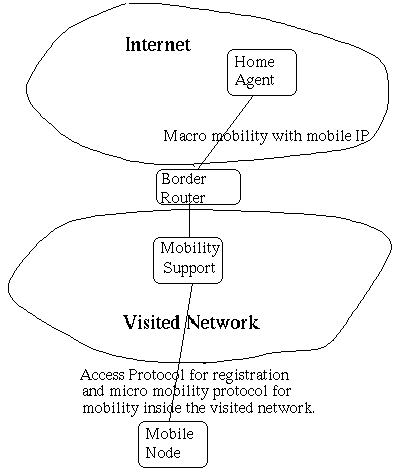
The Mobile IPv6 handles the macro mobility and the micro mobility solutions should not try to replace it. The micro mobility protocols should be Mobile IPv6 enhancements as in mobile IPv4. It would be possible to modify all the protocol proposals described in details in section 2 to be able to operate in Mobile IPv6 environment.
One of the interesting micro mobility standard proposals in Mobile IPv6 is the so called Hierarchical Mobile IPv6 Proposal. It is strongly related to the regionalized tunnel management protocols that have been defined to enhance the mobile IPv4 [7].
If we assume that the coexistence is possible, then every network administrator can choose which micro mobility solution she wants to use inside her network, but her choice will not affect mobile nodes, home agents, or the micro mobility solutions in other parts of the Internet. This would lead to a situation where the best technologies would probably win the race and become the most popular.
| [1] | C. Perkins., RFC 2002 - IP Mobility Support, October 1996
< http://www.cis.ohio-state.edu/htbin/rfc/rfc2002.html |
| [2] | C. Perkings., Work in progress, INTERNET DRAFT - Mobility Support in
IPv6, 10.3.2000
< http://www.ietf.org/internet-drafts/draft-ietf-mobileip-ipv6-11.txt > |
| [3] | E. Gustafsson, A. Jonsson, C. Perkins., Work in progress, INTERNET
DRAFT - Mobile IP Regional Tunnel Management, 6.3.2000
< http://www.ietf.org/internet-drafts/draft-ietf-mobileip-reg-tunnel-02.txt > |
| [4] | A. Campbell, J. Gomez, C-Y. Wan, S. Kim, Z. Turanyi, A. Valko., Work
in progress, INTERNET DRAFT, Cellular IP, January 2000
< http://www.ietf.org/internet-drafts/draft-ietf-mobileip-cellularip-00.txt > |
| [5] | IP micro-mobility support using HAWAII
< http://www.ietf.org/internet-drafts/draft-ietf-mobileip-hawaii-00.txt > |
| [6] | C. Castelluccia, L. Bellier., Toward a Unified Hierarchical Mobility
Management Framework, 25.6.1999
< http://www.inrialpes.fr/planete/people/ccastel/draft.txt > |
| [7] | C. Castelluccia., HMIP - A Hierarchical Mobile IPv6 Proposal, November
1998
< http://www.inrialpes.fr/planete/people/ccastel/ > |
| [8] | P. Ferguson, D. Senie., RFC 2267, Network Ingress Filtering: Defeating
Denial of Service Attacks which employ IP Source Address Spoofing, January
1998
< http://www.faqs.org/rfcs/rfc2267.html > |
| [9] | G. Montenegro,. RFC 2344, Reverse Tunneling for Mobile IP, May 1998
< http://www.faqs.org/rfcs/rfc2344.html > |
| [10] | S. Foo, K. Chua., Work in progress, INTERNET DRAFT - Regional Aware
Foreign Agent (RAFA) for Fast Local Handoffs, November 1998
< http://mip.ee.nus.edu.sg/paper/draft-chuafoo-mobileip-rafa-00.txt > |
| [11] | D. Forsberg, J.T. Malinen, J.K Malinen, T. Weckström, M. Tiusanen.,
Distributing Mobility Agents Hierarchically under Frequent Location Updates,
Sixth IEEE International Workshop on Mobile Multimedia Communications (MOMUC'99),
San Diego 1999.
< http://www.cs.hut.fi/Research/Dynamics/ > |
| IETF's current Mobile IP related drafts
< http://www.ietf.org/ids.by.wg/mobileip.html > |
|
| C. Perkins., Mobile Networking Through Mobile IP, 3.12.1999
< http://computer.muni.cz/internet/v2n1/perkins.htm > |